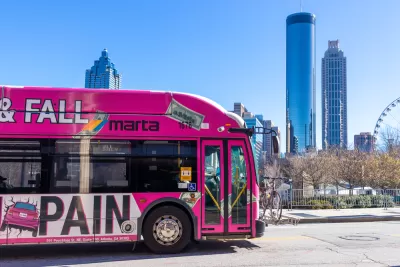From small rural towns to metro Atlanta, Georgia communities are experimenting with on-demand transit to improve connections to existing transit and offer transportation to isolated communities.

“In the past 18 months, on-demand transit has launched across Georgia, from Atlanta to Valdosta to Gainesville,” writes John Ruch. “Advocates and critics differ on the details while agreeing on-demand has its place and its unknowns.”
“Providing fast, low-cost service for last-mile connectivity and other short trips has been difficult and it limits the appeal of transit as a mode of travel. If we can solve that problem with services like the Buc and MARTA Reach, we can make it much easier for people to choose transit,” said Jim Durrett, executive director of the Buckhead Community Improvement District (CID), which funded the Buc shuttle in that neighborhood.
Critics say on-demand transit is “inherently far less efficient than fixed-route buses,” making it “best suited to small-town, rural and suburban-sprawl areas” as an option for hard-to-reach areas with few other transit options. This is exactly how several small Georgia communities, such as Valdosta and Hall County, are using it. In a much larger city, Atlanta’s MARTA is exploring microtransit as a solution for other goals. “In metro Atlanta, two new on-demand programs are aimed at ‘last-mile connectivity’ for fixed-route transit riders, with the implication of boosting overall transit ridership.”
The next six months, writes Ruch, should provide a clearer picture of how effective on-demand transit programs will be in increasing ridership and bringing transit access to more Georgians.
FULL STORY: On-demand transit expands across Georgia, putting pitches and criticisms to the test

Study: Maui’s Plan to Convert Vacation Rentals to Long-Term Housing Could Cause Nearly $1 Billion Economic Loss
The plan would reduce visitor accommodation by 25,% resulting in 1,900 jobs lost.

North Texas Transit Leaders Tout Benefits of TOD for Growing Region
At a summit focused on transit-oriented development, policymakers discussed how North Texas’ expanded light rail system can serve as a tool for economic growth.

Why Should We Subsidize Public Transportation?
Many public transit agencies face financial stress due to rising costs, declining fare revenue, and declining subsidies. Transit advocates must provide a strong business case for increasing public transit funding.

How to Make US Trains Faster
Changes to boarding platforms and a switch to electric trains could improve U.S. passenger rail service without the added cost of high-speed rail.

Columbia’s Revitalized ‘Loop’ Is a Hub for Local Entrepreneurs
A focus on small businesses is helping a commercial corridor in Columbia, Missouri thrive.

Invasive Insect Threatens Minnesota’s Ash Forests
The Emerald Ash Borer is a rapidly spreading invasive pest threatening Minnesota’s ash trees, and homeowners are encouraged to plant diverse replacement species, avoid moving ash firewood, and monitor for signs of infestation.
Urban Design for Planners 1: Software Tools
This six-course series explores essential urban design concepts using open source software and equips planners with the tools they need to participate fully in the urban design process.
Planning for Universal Design
Learn the tools for implementing Universal Design in planning regulations.
Ascent Environmental
Borough of Carlisle
Institute for Housing and Urban Development Studies (IHS)
City of Grandview
Harvard GSD Executive Education
Toledo-Lucas County Plan Commissions
Salt Lake City
NYU Wagner Graduate School of Public Service





























